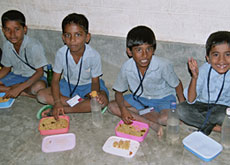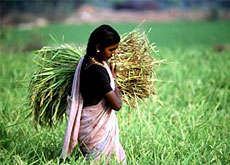Fortified rice offers hope to poorest children

Swiss researchers have found a way of adding iron to rice, an inexpensive technique which could improve the diets of children in the developing world.
A study carried out among iron-deficient children in India indicated that the fortified rice also significantly reduced levels of harmful lead in the children’s blood.
The findings of the 16-week study have just been published by the Federal Institute of Technology in Zurich.
Rice – a staple of one-third to one-half of the Earth’s population – was the only cereal which scientists had been unable to successfully fortify with iron. Previous attempts failed because it was impossible to produce a rice with a natural colour.
After three years’ work the Zurich scientists succeeded in creating an iron powder which could be mixed with powdered rice and compressed to produce rice-like whiteish grains. The resulting “rice” was mixed with normal rice in a ratio of one to 50.
“This is a breakthrough because it’s the first time rice has been successfully fortified with iron,” lead scientist Michael Zimmermann told swissinfo.
A total of 134 primary school children in Bangalore were involved in the research project. All suffered iron deficiency and some were anaemic. A section were fed a daily lunch comprising the enriched rich, while a control group received normal rice.
After 16 weeks the number of children with high lead concentrations in their blood had fallen from 65 per cent to 29 per cent, while those with iron deficiency had dropped from 78 to 29 per cent.
Lead poisoning
The World Health Organisation estimates that two billion people – more than 30 per cent of the world’s population – suffer from anaemia, mainly as a result of iron deficiency.
Another problem in overcrowded urban areas in Africa, India and Asia is air pollution, and in particular lead emissions to which children are particularly susceptible. Around three-quarters of children in developing countries are thought to have unacceptable levels of lead in their bodies, which can harm their development.
Zimmermann said it had not been known before the study in India that providing extra iron to these children could reduce lead levels.
After 16 weeks it was too early to detect signs of improved health in the Bangalore children, he said, but added that some of the teachers had noted improvements in the pupils’ attention span.
Zimmermann said the technique – involving inexpensive rice flour – could be used around the world with potential health benefits for millions of children.
“There is no patent on this technique so it can be used anywhere,” he said.
swissinfo, Morven McLean
The World Health Organization estimates that two billion people worldwide have anaemia, a deficiency of red blood cells or haeomoglobin in the blood.
It believes approximately 50% of all anaemia can be attributed to iron deficiency.
Iron deficiency anaemia (IDA) can have severe consequences for children’s mental and physical development.

In compliance with the JTI standards
More: SWI swissinfo.ch certified by the Journalism Trust Initiative

You can find an overview of ongoing debates with our journalists here . Please join us!
If you want to start a conversation about a topic raised in this article or want to report factual errors, email us at english@swissinfo.ch.